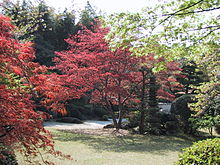Senescence in plants
The senescence (from Latin senescere = "getting old, aging") is at plants a genetically controlled and energy-dependent aging process . The extent to which this definition also applies to aging in humans and animals is a subject of research in biogerontology .
Senescence affects the whole plant, individual organs such as flowers , fruits and leaves or individual cells such as trichomes , tracheids and vascular elements . At least with leaf senescence, the process is reversible. The removal of the shoot leads to the re- greening of the lower leaves. For soybeans , it has been shown that cutting off the flowers and pods leads to a delay in leaf senescence. The Blütenseneszenz by removing young flower buds delayed. The nutrients from senescent tissues are transported into non-senescent tissues by the stem axis or by reproductive organs (flowers, seeds and fruits).
In the course of senescence, proteins to maintain photosynthesis are synthesized to a reduced extent, whereas other proteins are increasingly expressed. These include
- hydrolytic enzymes : breakdown of proteins, nucleic acids and lipids
- the glutamine synthetase : Synthesis of Glutamine
- the asparagine : Synthesis of asparagine
- Enzymes for the synthesis of ethene : acceleration of fruit ripeness and leaf senescence; Abscission (separation) of leaves, flowers and fruits
While lipids are converted into sucrose via the glyoxylate cycle and gluconeogenesis , the breakdown of nucleic acids and proteins leads to the synthesis of glutamine and asparagine. Like sucrose, these amino acids are transported out of the senescent tissues and can be recycled by other parts of the plant.
The senescence and abscission of the leaves are regulated by phytohormones : Ethene accelerates the senescence, cytokinins inhibit it (antisenescence). Senescence could be triggered by decreased photosynthetic activity. The process begins with the reversible conversion of chloroplasts to gerontoplasts , which may a. characterized by a reduced chlorophyll content and a lack of division activity, while the cell nuclei are only destroyed at the end of senescence. The end products of chlorophyll breakdown are stored in the vacuole , which later releases the cell sap with proteolytic enzymes into the cytoplasm .
After the chlorophyll has broken down, the carotenoids that are still retained give the autumn leaves a yellow to orange color, which was previously masked by the green of the chlorophyll . Some deciduous tree species synthesize anthocyanins , especially on cold, sunny autumn days , which cause the leaves to turn red. Anthocyanins protect the cells from too much light and thus from oxidative stress . This prevents the nutrient recovery from senescent leaves from ending prematurely. In the course of leaf abscission at the end of the senescence phase, the reduction in auxin synthesis in the leaf blade leads to increased ethene production. Ethene then induces the production and release of enzymes in the small, thin-walled parenchymal cells of the abscission zone on the petiole, which destroy the cell walls and thus cause the leaves to separate.
literature
- Buchanan-Wollaston V (1997): The molecular biology of leaf senescence . J Exp Bot 307, pp. 181-199
- Taiz, L. & Zeiger, E. (2006): Plant physiology
- Taylor, S. et al. (2001): Why Leaves Turn Red in Autumn. The Role of Anthocyanins in Senescing Leaves of Red-Osier Dogwood . Plant Physiology, Vol. 127, pp. 566-574
- Leaf Color Bibliography , Harvard Forest

